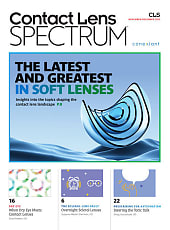As presbyopia continues to affect a growing portion of the population, progressive lenses remain the go-to solution for multifocal vision correction—but the landscape is evolving rapidly.
According to a report by Maximize Market Research, the global progressive lenses market was valued at $6.54 billion in 2024 and is projected to reach $11.93 billion by 2032, growing at a compound annual growth rate of 7.8%. This significant jump can be attributed to increasing screen use and PAL adoption expanding to younger, early presbyopes in their late 30s and early 40s.

For eyecare professionals, the increasing patient demand underscores the importance of staying informed about the latest lens technologies and fitting innovations. From AI-driven personalization to biometric and free-form surfacing, modern progressive lenses are designed to meet increasingly complex patient needs, offering ECPs opportunities to enhance satisfaction, address vision challenges proactively, and differentiate their practices in a competitive market.
On the following pages, EB rounds up key launches that hit the PAL market in 2025.
EssilorLuxottica’s Varilux Physio
EssilorLuxottica has introduced Varilux Physio extensee progressive lenses, its first design developed using a dynamic pupil model to address changes in pupil size under varying light conditions.

The new lenses are available in two versions: Varilux Physio extensee on a dual-sided blank and Varilux Physio extensee Classic Edition as a full backside digital progressive. Positioned as mid-tier offerings within the Varilux portfolio, the lenses incorporate EssilorLuxottica’s AI Twinning technology—a dynamic pupil model that simulates thousands of wearer profiles performing tasks at different distances under varying light conditions. The system analyzes these simulations to predict pupil size variation and inform the development of Pupilizer lens technology, which reduces high-order aberrations, according to the company.
Additional features include Dual Booster lens surface technology to enhance near-vision tasks, Synchroneyes for binocular vision management, and an option to personalize the near-vision zone using Near Vision Behavior measurement, EssilorLuxottica shares.

Hoya Vision Care’s VisuPro
Hoya Vision Care has launched VisuPro All Day and VisuPro Flex lenses, designed for individuals aged 36 to 44 who are beginning to experience early presbyopia.
VisuPro lenses incorporate two core technologies: Focus Max Optimization enhances near vision and aims to reduce digital eye strain, while Binocular Harmonization Technology balances prescriptions between both eyes for improved focusing, stability, and depth of vision, Hoya shares.
VSP Optics’ Unity V3
VSP Optics has released Unity V3 Progressive Lenses, developed using artificial intelligence and advanced optical design to provide customized vision correction, according to the company.

The Unity V3 design uses an AI predictive model informed by more than 8 million prescriptions and 500,000 data points, incorporating gaze pattern analysis to optimize near, intermediate, and distance vision zones, VSP shares. The lens is engineered to provide a wider field of vision, reduce the “swim” effect, and position aberrations outside areas commonly used for reading and daily tasks.
Unity V3 lenses can be dispensed during a standard eye exam without the need for additional equipment.
Balancing Cost + Clarity
When it comes to recommending progressive lenses, success hinges on balancing education, lifestyle-driven recommendations, and confidence in the product. EB connected with Ron Krefman, OD, author of EB’s Optometric Business Tracker, for tips on helping patients make informed choices that fit both their needs and budgets.
EB: What evidence, feedback, or data do you use to educate patients about trade-offs between cost and performance and reinforce confidence in the products you recommend, especially higher-end PAL options?
Dr. Krefman: Premium (personalized or free-form) progressive addition lenses generally produce less unwanted distortion and are preferred by about 80% to 82% of users over conventional standard PALs, according to several double-blind or crossover studies.
EB: Can you offer tips for balancing entry-level versus premium PALs in your product mix, in order to serve both cost-sensitive and performance-oriented patients?
Dr. Krefman: Research from focalCenter and GPN Technologies, “Market Check: Are You Charging the Right Price for Progressives?” shows that, nationwide, 70% of PALs list for over $550. Offer two or three tiers with transparent pricing and use staff scripts that describe the difference between “basic, reliable vision correction” and premium designs offering reduced distortion, improved visual comfort, and higher satisfaction.
EB: How do you assess a patient’s lifestyle (digital device use, reading habits, occupational tasks) to recommend the most appropriate PAL option rather than just the lowest price?
Dr. Krefman: Throughout the visit, engage in a continuous dialogue to gather the patient’s lifestyle needs.
For more tips on educating patients about progressive lenses, see this installment of Back to Basics.



